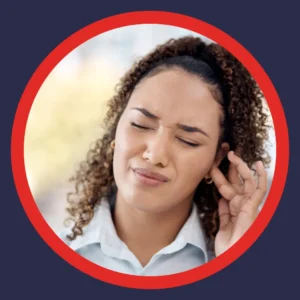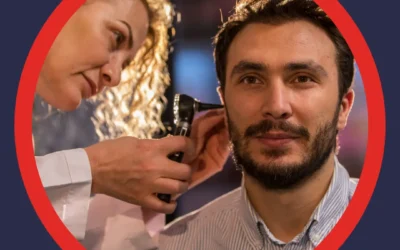That whoosh or ring in your ear is not imagined. For many people, hypertension and tinnitus travel together. High blood pressure strains tiny ear vessels and alters inner ear function. When pressure and flow change, sound can feel different.
Hypertension means blood force against artery walls stays too high. Over time, that pressure stresses delicate structures in the cochlea and balance system. The result may be ringing, muffled hearing, fullness, or dizziness. The good news: you can measure blood pressure and you can measure hearing. Data guides decisions.
Steadier circulation often equals steadier hearing.
How High Blood Pressure Affects the Inner Ear
The Cochlea Runs on Blood Flow
Your cochlea is a high-metabolism organ. It needs steady oxygen and nutrients. Tiny arteries feed rows of delicate hair cells. These cells convert sound into electrical signals for your brain. When pressure stays high, vessel walls stiffen. Flow can drop in fragile capillaries. Hair cells then struggle, and some may fail.
Researchers have linked arterial hypertension with a higher likelihood of tinnitus. The association appears stronger in older adults. See the supporting research on arterial hypertension and tinnitus.
Inner Ear Pressure Balance and Spatial Awareness
Your inner ear balances pressure to keep you oriented. The system is precise. Changes in vascular tone or fluid pressure can disturb that balance. Hearing may feel muffled. Sounds can seem distorted. Some people notice ear fullness or mild imbalance.
What Actually Changes When Blood Pressure Stays High
The inner ear can react in several specific ways:
- Reduced cochlear perfusion limits oxygen delivery to hair cells.
- Hair cells do not regenerate after injury in most cases.
- Strained vessels may alter the endolymph environment.
- Nerve signaling can slow when support cells lack nutrients.
- The brain receives a weaker or noisier signal from the ear.
These changes help explain why hypertension and tinnitus often appear together.
The Big Four Ear Symptoms Linked to Hypertension
High blood pressure can show up in your ears. These four symptom groups appear most often. Each can range from mild to disruptive.
Hearing Loss
- Sounds seem softer than expected.
- Speech clarity drops in noise.
- You turn the TV up more than before.
- Friends say you miss parts of conversations.
Tinnitus
- You notice a ring, buzz, hiss, or hum.
- The sound changes with stress or poor sleep.
- It may live in one ear or both.
- Learn about common types of tinnitus.
Vertigo or Imbalance
- The room feels off or unsteady.
- Quick head turns trigger brief spinning.
- You avoid dark rooms where balance is harder.
- Walking on uneven ground feels risky.
Ear Fullness or Pressure
- Your ear feels clogged without cold symptoms.
- You pop your ears often for relief.
- Sounds feel dull or slightly distorted.
- Pressure fades and returns without warning.
These patterns point toward changes in ear blood flow and pressure control.

Pulsatile Tinnitus: When You Hear Your Heartbeat
Pulsatile tinnitus sounds rhythmic. It often syncs with your heartbeat. Changes in blood flow near the ear can create that sound. High blood pressure can play a role by increasing vascular strain.
Most cases have an identifiable source. Many resolve when you treat the cause. Population data suggest meaningful ties between tinnitus and cardiovascular health. See this concise BMJ Public Health analysis.
When To Seek Prompt Medical Care
Pulsatile tinnitus deserves timely evaluation. Call your doctor soon if you notice any of the following:
- Sudden hearing loss in one ear or both.
- New one-sided tinnitus that pulses with your heartbeat.
- Severe or unusual headache with ear noise.
- Vision changes, weakness, numbness, or trouble speaking.
- New dizziness with unsteady walking.
Early attention often leads to clearer answers and better relief.
What the Research Says About Hypertension and Hearing Changes
Evidence links long-standing high blood pressure with ear changes. Patterns appear in both hearing and tinnitus.
- Longer hypertension duration correlates with more hearing loss.
- Older adults show a stronger association between hypertension and tinnitus.
- Vascular strain can reduce cochlear blood flow.
- Reduced flow stresses hair cells that do not regenerate.
- Treating cardiovascular risks often improves ear symptoms.
For a clear overview, see this peer-reviewed summary of hypertension and auditory effects. Findings guide expectations while you plan next steps.
Care teams also consider medications, since treatment choices can influence symptoms.

Could Blood Pressure Medication Affect Tinnitus?
Blood pressure control protects your heart and brain. It often helps your ears. Some patients still notice ringing with certain drug classes. Do not change medication without your prescriber.
The table below summarizes common reports at a high level. It is not medical advice.
Blood Pressure Medications and Tinnitus: What Patients Report
|
Drug Class |
Common Examples |
Tinnitus Reported? |
Typical Clinical Approach |
|
ACE inhibitors |
lisinopril, enalapril |
Sometimes reported |
Discuss options if symptoms persist |
|
Diuretics (thiazide, potassium-sparing) |
HCTZ, chlorthalidone, spironolactone |
Sometimes reported |
Monitor; consider alternatives if needed |
|
Calcium channel blockers |
amlodipine, diltiazem, nifedipine |
Sometimes reported |
Adjust dose or agent if appropriate |
|
Certain beta blockers |
metoprolol, bisoprolol |
Occasionally reported |
Case by case with your prescriber |
|
ARBs as monotherapy |
candesartan, olmesartan, telmisartan |
Not commonly reported |
Often reasonable options |
Most people tolerate therapy well and benefit from stable blood pressure. If ringing starts after a new medication, call your doctor. Simple adjustments can help while you keep pressure controlled.
Hearing changes also deserve attention beyond prescriptions.
When Hearing Loss Enters the Picture
High blood pressure often coexists with age-related auditory change. Shared vascular stress explains much of it. Reduced cochlear perfusion starves hair cells of oxygen. Damaged cells do not regenerate. Speech clarity then drops, especially in noise and echo.
Hypertension can influence classic patterns on hearing tests. Low-to-mid frequencies may fall first with vascular strain. High frequencies often decline with age and noise. The result feels uneven and frustrating. You catch volume, but you miss meaning. Listening becomes work.
How it affects daily life
- Conversations take effort, even with close family.
- Background noise blurs consonants and key words.
- You raise the TV but still miss plot details.
- Phone calls require repeats or captions.
- Alarms, timers, and doorbells become easy to miss.
- Group events drain energy within minutes.
- Driving feels tense when you cannot localize sirens.
Why testing matters now
- Audiometry maps frequency-by-frequency sensitivity.
- Speech-in-noise testing reveals real-world struggle.
- Tympanometry rules out middle-ear contributors.
- Counseling sets realistic goals and next steps.
You can start with targeted strategies that fit daily routines. Read practical guidance for bilateral hearing loss. The right plan reduces strain and restores confidence.
Why Evaluations and Hearing Tests Matter
Testing turns vague symptoms into a clear map. It also guides smart referrals. A structured visit answers three questions. What do you hear. How loud is the tinnitus. What else might be driving it.
What to expect at a tinnitus and hearing appointment
- Case history: Health review, medications, noise exposure, sleep, and stress.
- Otoscopy: A quick look for wax or eardrum changes.
- Tympanometry: Checks middle ear pressure and eardrum movement.
- Pure-tone testing: Finds the softest sounds you can detect by pitch.
- Speech testing: Measures clarity in quiet and in background noise.
- Tinnitus measures: Pitch and loudness matching when appropriate.
- Counseling: Results explained in plain language with next steps.
Testing supports medical teamwork. Findings can inform your primary care or cardiology plan. They also shape options like sound therapy and hearing aids. For balanced expectations, see this concise hearing aids and tinnitus research.
Clear results make the next choices simpler.
Treatment Pathways: What You Can Do Now
Start with blood pressure control. It protects your heart and your hearing. Good control often quiets tinnitus and reduces ear fullness.
Blood pressure basics to prioritize
- Take readings at consistent times.
- Log numbers to spot trends.
- Follow your prescriber’s plan without skipping doses.
- Ask about targets that fit your risk profile.
- Bring your cuff to visits to verify accuracy.
Hearing aids and sound therapy
- Amplification restores missing sound and reduces listening strain.
- Many devices include built-in maskers for gentle relief.
- Consistent wear times build benefit over weeks, not days.
- Pair devices with relaxing sound at bedtime for sleep.
- Explore options in this overview of best hearing aids for seniors with tinnitus.
CBT-based tinnitus management
- CBT teaches practical skills to reduce distress.
- You learn to redirect attention away from the noise.
- Skills improve sleep and reduce stress spikes.
- Programs work well alongside hearing aids and masking.
Daily habits that support progress
- Set a steady sleep routine.
- Cut excess sodium and ultra-processed foods.
- Limit nicotine, caffeine, and alcohol when symptoms flare.
- Add light exercise most days of the week.
- Protect ears from loud bursts with simple plugs.
Small, steady changes compound.
Everyday Triggers and Habits That Influence Both
Daily choices shape how your ears feel. They also shape blood pressure. Small tweaks can calm both.
Common triggers to watch
- Stress spikes: Cortisol lifts blood pressure and can make ringing louder.
- High sodium: Packaged foods push pressure higher and dull sound clarity.
- Nicotine: Vessels constrict, and ears get less oxygen.
- Alcohol and caffeine: Large doses can raise pressure and increase noise awareness.
- Poor sleep: Short nights raise pressure and reduce coping.
- Loud sound bursts: Concerts and tools add extra strain to fragile hair cells.

Habits that help
- Build a simple wind-down routine before bed.
- Batch-cook low-sodium meals for busy nights.
- Replace one coffee with herbal tea.
- Set smoke-free goals with support.
- Plan short, daily walks to ease stress.
- Carry earplugs for sudden loud settings.
If you want food ideas that support ear health, see how a diet can lower tinnitus risk. Small shifts add up over weeks and months.
Consistent tools make steady change easier.
Apps and Tools That Help You Cope
Digital tools make sound management simpler. The right features reduce stress and improve sleep.
What to look for in an app
- Sound libraries: White noise, nature, and pink noise options.
- Masking controls: Easy sliders for volume and tone.
- Timers: Gentle ramp-down for bedtime sessions.
- Breathing guides: Visual pacing to lower stress.
- Sleep tracking: Simple trends to spot triggers.
- Device pairing: Smooth use with hearing aids or speakers.
These tools support your plan. They do not replace care. Explore practical picks and tips in this guide to apps for tinnitus relief.
Access and affordability matter too, especially when devices help daily function.
Access and Affordability
Do not delay help because of cost worries. Many patients discover options that fit.
Ways to make care more affordable
- Check plan details before your visit.
- Ask about in-network benefits for testing and devices.
- Use HSA or FSA funds for eligible services.
- Request written estimates for transparency.
- Explore financing with clear monthly terms.
- Save on batteries and supplies with subscriptions.
If you are unsure what your plan covers, review your hearing aid insurance benefits. Clarity removes guesswork and speeds decisions.
A clear plan also sets realistic expectations.
Can You Really Get Rid of Tinnitus?
Some cases quiet down with solid blood pressure control. Others improve with hearing support and stress skills. A few persist despite good care.
What often predicts better outcomes
- Hypertension caught and controlled early.
- Consistent use of amplification when hearing loss exists.
- Regular sleep and lower stress reactivity.
- Limited loud sound exposure over time.
- Realistic goals and steady follow-up.
For a grounded overview, read this guide on whether you can get rid of tinnitus. Most people find relief with a layered plan.
Prevention helps protect the progress you make.
Prevention Starts Today
Protecting hearing pays off at every age. Small habits reduce risk and stress.
Simple prevention wins
- Wear earplugs at concerts and games.
- Set phone volume warnings and obey them.
- Take listening breaks during long sessions.
- Check blood pressure at home each week.
- Keep annual hearing checks on your calendar.
- Move your body most days, even 15 minutes helps.
See ideas worth sharing during Protect Your Hearing Month. Prevention supports every other step you take.
When you are ready, local care makes action easy.
Ready To Hear the Difference Good Care Makes?
Schedule a tinnitus evaluation and free hearing test with American Hearing + Audiology. Our team coordinates with your medical providers to support blood pressure goals and ear health. Book a visit and start a plan that fits your life.



